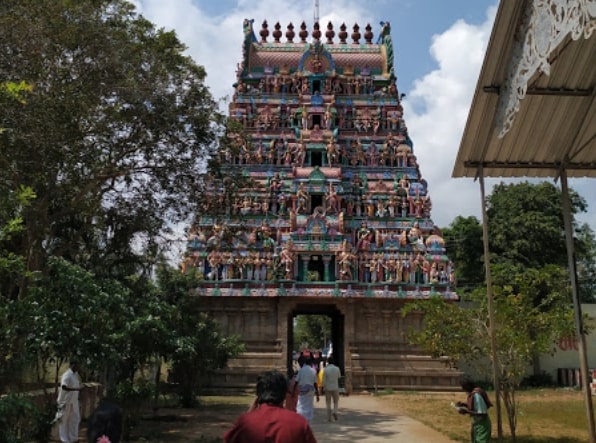Tiruvenkadu Sri Swetharanyeswarar Temple, Nagapattinam

Address
Tiruvenkadu Sri Swetharanyeswarar Temple, Tiruvenkadu ,Sirkazhi Taluk,Nagapattinam District PIN 609114 PH:043644-256424
Diety
Swetharanyeswarar, Amman: Brahmavidyanayagi
Introduction
Swetharanyeswarar Temple is a Hindu temple dedicated to the deity Shiva, located in Thiruvenkadu, a village in Mayiladuthurai district in the South Indian state of Tamil Nadu. Shiva is worshiped as Swetharanyeswarar, and is represented by the lingam. His consort Parvati is depicted as Brahmavidyambigai. The presiding deity is revered in the 7th century Tamil Saiva canonical work, the Tevaram, written by Tamil saint poets known as the Nayanars and classified as Paadal Petra Sthalam. It is significant to the Hindu sect of Saivism as one of the temples associated with the nine planet elements, the Navagraha Stalas, and specifically Budha. The temple complex covers around two acres and entered through a seven-tiered gopuram, the main gateway. The temple has a number of shrines, with those of Swetharanyesarar, Aghora and that of Nataraja, being the most prominent. All the shrines and the three temple tanks of the temple are enclosed in large concentric rectangular granite walls. Theertham (Holy water): Surya, Chandra and Agni Theerthams Sthala Vriksham (Sacred Tree): Vadavaal, Vilvam and Kondrai trees
Puranic Significance
This temple is mentioned in Valmiki Ramayan and Silapathikaram. This underscores the antiquity of this temple. The name of this place in Sanskrit is “Swetharanyam” (“Sweth” means white and “Aranyam” means forest). In Tamil, this can be translated as “Venmai” meaning “white” and “Kaadu” meaning forest.Hence this place is called “Thiru Venkaadu”. The lord here is known as “Sri Swetharanyeswarar”. Lord Shiva here is also praised as Thiruvenkaadar, Thiruvenkaattu Devar, Thiruvenkaadaiyar and Thiruvenkaattu Peruman. There are stone inscriptions available here which relate to the period of Chola Kings Adhithiyan, Rajarajan, Rajendran, kulothungan, Vikrama Cholan and Rajathirajan. Some stone inscriptions relate to Pandiya kings Kulasekara Pandiyan, Vikrama Pandiyan, Sundara Pandiyan and Parakirama Pandian. There are also some stone inscriptions dating back to the Vijayanagar dynasty. This temple’s campus covers an area of almost 12 acres. The rivers, Kaveri and Manikarnigai, flow near this holy shrine. It is believed that taking dip in the river Manikarnigai is equivalent to taking dips in the 64 bath ghats in Kasi. Lord Budhan. It is believed that Budhan performed his penance here and was relived from his “ali dosham”. Brahma Samaadhu (Brahma Adhishtanam) Another legend associated with this temple is that of Lord Brahma. It is believed that Lord Murugan imprisoned Lord Brahma for not being able to explain the meaning of “Pranava Mantra” (Aum / Om). Lord Shiva himself went to Lord Murugan and explained him the importance of Lord Brahma’s work which were being put on hold due to his captivity. Lord Shiva then got Lord Brahma released. Because of the imprisonment, Lord Brahma forgot the Brahmagnanam” (his duty of maintaining balance in the world). It is believed that Lord Brahma came to this place and performed rigorous penance in order to regain his memory. The method of penance he adopted here is known as “Samaadhu Nilai” (by holding his breath). Pleased with his penance, Lord Shiva, in the form of Lord Dakshinamurthy, taught him the “Brahmagnanam” again. Also, Goddess Parvathy is believed to have taught him the “Brahma Kalai” (“arts of brahma”). Hence, Goddess Parvathy here is known as “Sri Brahma Vidhyambigai”. There is a separate shrine here in the name of “Brahma Samaadhu”.
Beliefs
This is a famous “Parihara sthalam” for Lord Budhan (Mercurry). Those suffering from nerve related ailments can worship lord Budhan here for relief. Lord Budhan is believed to be the lord responsible for education and business. Hence, devotees believe that by worshiping lord Bhudan,they will be blessed with better education, knowledge, wisdom, oratory excellence and improvement in their businesses. Devotees also believe that worshiping the lord here will lead to removal of sins accrued in their previous births. It is believed that those seeking wedding boon and “santhana prapthi” (child boon) can pray to the lord here.
Special Features
This is one of the 276 Devara Paadal Petra Shiva Sthalams and 11th Shiva Sthalam on the northern bank of the river Cauvery in Chozha Nadu (Vadakarai). Lord Shiva in this temple is a Swayambumurthi (self-manifested). This is one of the famous Navagraha “parihara sthalam” – Lord Budhan (Mercury) is represented here. This is one of the 51 Shakthi Peetams – Goddess Parvathy is praised here as “Pranava Shakthi”. This temple is one of the 6 Shiva Sthalams on the banks of river Cauvery that are considered to be equal in significance with Kasi (Banaras). The others being (1) Thiruvaiyaru, (2) Mayiladuthurai, (3) Chayaavanam, (4) Thiruvidaimaruthur, and (5) Thiruvanchiyam. This is one of the 44 Paadal petra sthalams where the “Moovar” (the three saints – Saint Thirugnanasambanthar, Saint Thirunavukarasar (Appar) and Saint Sundaramurthy (Sundarar) had rendered their Pathigams. This temple has five corridors and its main tower (Rajagopuram) has 5-tiers.
Festivals
13-day Brahmotsavam (Indra Vizha) in the Tamil month of Masi (Feb-Mar), 10-day Aadi Pooram in the Tamil month of Aadi (Jul-Aug), Vinayakar Chaturthi in the Tamil month of Aavani (Aug-Sept), Navrathiri in the Tamil month of Purattasi (Sept-Oct),
Century/Period/Age
1000-2000 years old
Managed By
Hindu Religious and Charitable Endowments (HRCE)
Nearest Bus Station
Tiruvenkadu
Nearest Railway Station
Sirkazhi
Nearest Airport
Trichy




